Introduction
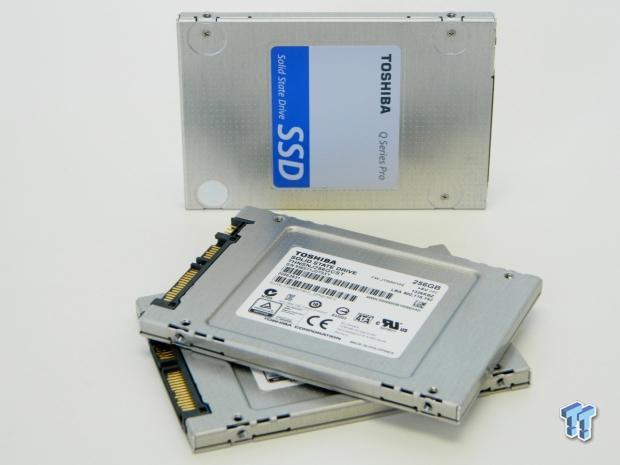
Toshiba's Q Series Pro is one of TweakTown's all-time favorite drives. It was our RAID champion for a while. The Q Series Pro was edged out as our two-drive RAID champion by SanDisk's Extreme II. Then along came Intel's 730, which ran away with the crown, and is our current RAID champion.
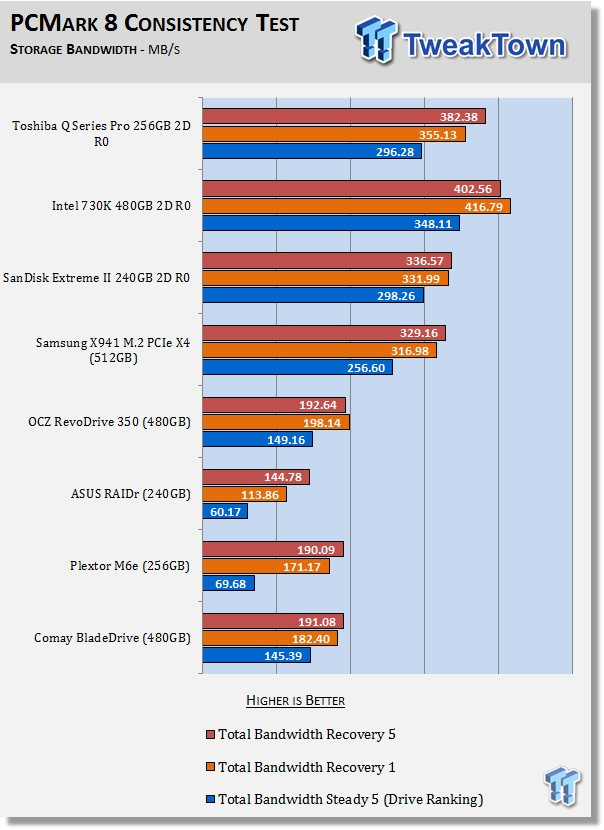
Looking at the chart above will show you exactly what happened. We consider Steady State (as represented by the blue bar) the most important metric, and rank our arrays accordingly.
If you have been following our RAID reports lately, we have been showing you why SATA RAID 0 is the fastest OS Disk you can own. As you can see, newly launched PCIe drives have proven to be no match for a two-drive array when utilized as an operating system volume. In addition, when you go PCIe you are giving up slots and or lanes, which is not something a serious gamer with two or three high-powered video cards is going to want to do.
I firmly believe that right now, a three-drive SATA array is the sweet spot for the enthusiast. It can deliver astounding performance for a relatively low cost. A good SATA array can even run with the newest NVMe drives and more than hold its own, as demonstrated here. A three-drive array is able to max-out the sequential read/write bandwidth of current Z87 and Z97 chipsets, which is why I consider a three-drive array more desirable than a two-drive array.
I recently got my hands-on a third Toshiba 256GB Q Series Pro, so of course we need to see what a three-drive array has got under the hood. Today we are doing a three-way, three-drive array showdown, featuring past and current RAID champions. Even though our two-drive Extreme II array was able to take down our two-drive Q Series Pro array, when you take a closer look the Toshiba array, you will notice it has better TRIM performance than the Extreme II array.
This may indicate that it will scale better than the Extreme II as we move to a three-drive array. Will Toshiba's low-cost, high-performance, Q Series Pro have what it takes to take down our reigning RAID champion? Let's find out!
PRICING: You can find the Toshiba Q Series Pro SSD for sale below. The prices listed are valid at the time of writing, but can change at any time. Click the link to see the very latest pricing for the best deal.
United States: The Toshiba Q Series Pro 256GB SSD retails for $139.99 at Amazon.
You can also find the Intel 730 Series 480GB SSD for $409.99 at Amazon, and the SanDisk Extreme II 240GB SSD for $179.99 at Amazon.
Canada: The Toshiba Q Series Pro 256GB SSD retails for CDN$199.81 at Amazon Canada.
You can also find the Intel 730 Series 480GB SSD for CDN$631.51 at Amazon Canada, and the SanDisk Extreme II 240GB SSD for CDN$182.50 at Amazon Canada.
Specifications, Drive Details, Test System Setup, Drive Properties, Pricing and Availability
Specifications

Toshiba's Q Series Pro 256GB SATA III SSD is available in three capacity sizes, 128GB, 256GB, and 512GB. Specifications list the 256GB Q Series Pro SSD as capable of 554MB/s sequential reads, and 512MB/s sequential writes. Random read/write speed is not listed. The Toshiba Q Series Pro is available in a 2.5" x 7mm z-height form factor. It also ships with a spacer, should you need to increase the drive's thickness to 9.3mm. Toshiba backs the Q Series Pro with an industry standard three-year warranty.
Because this is a RAID review, we are going to focus on performance rather than features. For a more in-depth look at the Toshiba Q Series Pro feature set, I will refer you to Chris Ramseyer's extensive review of Toshiba's Q Series Pro.
Drive Details - Toshiba Q Series Pro 256GB SSD

Toshiba's Q Series Pro comes packaged in an attractive box colored black, green, and white. There is a picture of the drive on the front of the box. The front of the box also states the drive's capacity, its SATA III interface, and that the drive is a slim 7mm in thickness. Sequential read/write speed is listed here as well.

The rear of the box lists some attributes of solid state drives.

The Q Series Pro ships with a warranty guide, a quick installation guide that tells you how to download the included NTI Echo cloning software, and a plastic spacer that can be used to increase the drive's thickness, should you need to do so.

The top of the drive's enclosure is formed from a single piece of stamped aluminum that is natural in color. There is a blue and white sticker centered on the front of the drive.
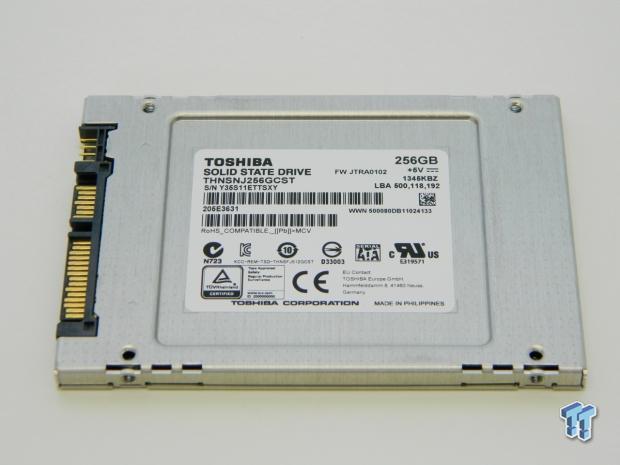
The bottom and sides of the enclosure are made from another piece of naturally colored, stamped aluminum. There is a sticker that lists the drive's part number, serial number, capacity, and shipping firmware revision.

Here's what Toshiba's Q Series Pro 256GB SSD looks like completely disassembled. The drive's controller and BGA NAND packages all have thick thermal pads stuck to them. These thermally conductive pads wick heat from the chips, and into the drive's aluminum enclosure. We removed a couple of the thermal pads to get a better look at the NAND packages, and the controller. There are eight Toshiba branded 32GB 19nm MLC Toggle Mode BGA NAND packages on this side of the PCB. The drive's controller is branded Toshiba, and there is no DRAM buffer.
Test System Setup

- Drive Properties

The majority of our testing is performed with our test drive/array as our boot volume. Our boot volume is 75% full for all OS Disk "C" drive testing to mimic a typical consumer OS volume implementation. We are using 64k stripes for our two and three drive arrays, and 32k stripes for our four to six drive arrays. Write caching is enabled, and Windows buffer flushing is disabled.
All of our testing includes charting the performance of a single drive, as well as RAID 0 arrays of our test subjects. We are utilizing Windows 8.1 64-bit for all of our testing. We will be posting screen shots of our drive array benchmarks.
Synthetic Benchmarks - ATTO, Anvil Storage Utilities, CrystalDiskMark & AS SSD
ATTO
Version and / or Patch Used: 2.47
ATTO is a timeless benchmark used to provide manufacturers with data used for marketing storage products.

Sequential read transfers max out at 1.588 GB/s. Sequential write transfers max out at 1.261 GB/s.
Sequential Write

We are seeing the same choppy synthetic performance that we saw in our previous Q Series Pro review. This choppy synthetic performance manifests itself only after the drive/array has been loaded up with data. The only review website you would ever see this particular performance information on is TweakTown.com, because we are the only review website to test with an OS Volume loaded up with data.
Sequential Read

Toshiba Q Series Pro arrays deliver massive sequential read performance, with our Q Series Pro three-drive array outperforming both our Extreme II and 730 arrays.
Anvil Storage Utilities
Version and / or Patch Used: RC6
Anvil's Storage Utilities is a storage benchmark designed to measure the storage performance of SSDs. The Standard Storage Benchmark performs a series of tests; you can run a full test, or just the read or write test, or you can run a single test (i.e. 4k QD16).

Anvil's is not so kind to our Q Series Pro arrays. This score is more like what we would typically see from a single drive.
Read IOPS through Queue Depth Scale

Anvil's read IOPS scaling is not choppy, but it's not too good either. Intel's 730 easily outperforms the Q Series Pro, and edges out the Extreme II to take the win in this test.
Write IOPS through Queue Scale

We are not entirely sure why the Q Series Pro falls on its face in this test, but it sure does fall on its face. We are seeing exactly the same thing we saw from a two-drive Q Series Pro array. When the Q Series is loaded up with data, it does not like synthetic testing; this is some sort of anomaly, because it rips through our real-world testing, delivering performance that is downright amazing.
CrystalDiskMark
Version and / or Patch Used: 3.0 Technical Preview
CrystalDiskMark is disk benchmark software that allows us to benchmark 4k and 4k queue depths with accuracy.
Note: Crystal Disk Mark 3.0 Technical Preview was used for these tests since it offers the ability to measure native command queuing at 4 and 32.

Unlike what we saw with a two-drive Q series Pro array, our three-drive array delivers mostly good performance in this test.

Sequential 512K, and 4k QD 32 look good for any array; 4k and 4k QD4 are exactly what we expect from a Q Series Pro array. These two categories are low in comparison to the other two arrays on our chart. Toshiba's Q Series Pro seems to defy logic in that its 4k read performance is low, but its real-world performance is stunning.

4k write performance is looking excellent, and is what we would expect to see from a top performing array. Sequential write is a little on the low side, and 512k write is downright terrible, but as we have seen in the past, for some reason benchmarks like CDM do not accurately predict what we will get from a Q Series Pro array when we subject it to the testing that matters, real-world simulations.
AS SSD
Version and / or Patch Used: 1.7.4739.38088
AS SSD determines the performance of Solid-State Drives (SSD). The tool contains four synthetic, as well as three practice tests. The synthetic tests are used to determine the sequential, and random read and write performance of the SSD.


For some unknown reason, AS SSD is our only synthetic test that agrees with Toshiba's Q Series Pro when it's loaded up with data and tested as it should be. Our three-drive Q Series Pro array delivers excellent performance, and it even manages to defeat one of our two contending arrays for the first time today. Next up is the important testing, and it's exactly what our Q Series Pro array has been waiting to sink its teeth into.
Benchmarks (Trace Based OS Volume) - PCMark Vantage, PCMark 7 & PCMark 8
Light Usage Model
We are going to categorize these tests as indicative of a light workload. If you utilize your computer for light workloads like browsing the web, checking emails, light gaming, and office related tasks, then this category of results is most relevant for your needs.
PCMark Vantage - Hard Disk Tests
Version and / or Patch Used: 1.2.0.0
The reason we like PCMark Vantage is because the recorded traces are played back without system stops. What we see is the raw performance of the drive. This allows us to see a marked difference between scoring that other trace-based benchmarks do not exhibit. An example of a marked difference in scoring on the same drive would be empty vs. filled vs. steady state.
We run Vantage three ways. The first run is with the OS drive/Array 75% full to simulate a lightly used OS volume filled with data to an amount we feel is common for most users. The second run is with the OS volume written into a "Steady State" utilizing SNIA's guidelines (Rev 1.1). Steady state testing simulates a drive/array's performance, similar to that of a drive/array that has been subjected to consumer workloads for extensive amounts of time. The third run is a Vantage HDD test with the test drive/array attached as an empty, lightly used secondary device.
OS Volume 75% Full - Lightly Used

OS Volume 75% Full - Steady State

Secondary Volume Empty - Lightly Used

As you can see, there's a big difference between an empty drive/array, one that's 75% full/used, and one that's in a steady state.
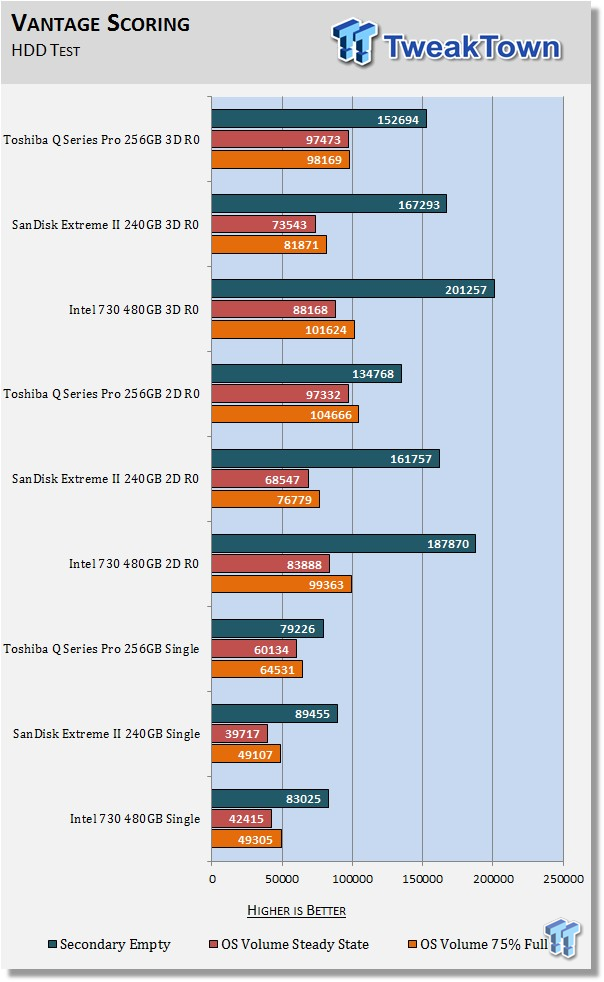
The important scores to pay attention to are "OS Volume Steady State" and "OS Volume 75% full." These two categories are most important because they are indicative of typical consumer user states.
When a drive/array is in a steady state, it means garbage collection is running at the same time it's reading/writing. This is exactly why we focus on steady state performance. Whether it's a single SSD, or a two or three-drive array, it does not matter; the Q Series Pro owns this test, and owns it where it matters most: in a steady state.
PCMark 7 - System Storage
Version and / or Patch Used: 1.4.00
We will look to the Raw System Storage scoring for RAID 0 evaluations, because it's done without system stops, and therefore allows us to see significant scoring differences between drives/arrays.
OS Volume 75% Full - Lightly Used

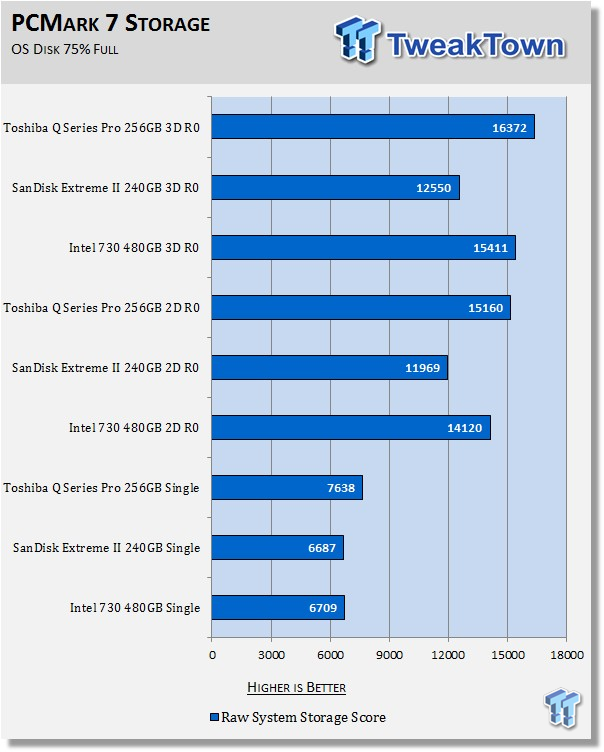
PCMark 7's storage test suite just drops right into the Q Series Pro's wheelhouse. Again, it does not matter whether it is a single SSD, or an array; the Q Series Pro easily defeats the competition.
PCMark 8 - Storage Bandwidth
Version and / or Patch Used: 1.2.157
We use the PCMark 8 Storage benchmark to test the performance of SSDs, HDDs, and hybrid drives with traces recorded from Adobe Creative Suite, Microsoft Office, and a selection of popular games. You can test the system drive, or any other recognized storage device, including local external drives. Unlike synthetic storage tests, the PCMark 8 Storage benchmark highlights real-world performance differences between storage devices.
OS Volume 75% Full - Lightly Used


IMFT flash-based arrays dominate this testing. Of course, the biggest performance increase is when you go from a single drive to a two-drive array. Take a quick look at the Extreme II's results. This is what we have typically seen from Toshiba flash-based drives. There is hardly any scaling as we move from a two to a three-drive array. The Q Series Pro bucks this trend, and delivers excellent scaling in comparison to the Extreme II; however, it's not enough to threaten our RAID Champion, the Intel 730 Series array.
Benchmarks (Secondary Volume) - Disk Response & Transfer Rates
Iometer - Disk Response
Version and / or Patch Used: 1.1.0
We use Iometer to measure disk response times. Disk response times are measured at an industry accepted standard of 4k QD1 for both write and read. Each test is run twice for 30 seconds consecutively, with a five second ramp-up before each test. The drive/array is partitioned and attached as a secondary device for this testing.
Write Response

Read Response

Average Disk Response

Write response times benefit most from RAID 0 because of write caching. There is a slight latency increase in read response times for an array vs. a single drive. Just like we saw from our round of synthetic testing, the Q Series Pro has lackluster read response. Write response is good, but not as good as our other two contenders.
DiskBench - Directory Copy
Version and / or Patch Used: 2.6.2.0
We use DiskBench to time a 28.6GB block (9,882 files in 1,247 folders) of mostly incompressible random data as it's transferred from our OS array to our test drive/array. We then read from a 6GB zip file that's part of our 28.6GB data block, in order to determine the test drive/array's read transfer rate. The system is restarted prior to the read test to clear any cached data, ensuring an accurate test result.
Write Transfer Rate

Read Transfer Rate


The Q Series Pro is all about real-world performance. Look at that read transfer performance; it's absolutely stunning. The Extreme II's superior 4k QD1 write performance delivers our best write transfer performance of the group.
Benchmarks (Secondary Volume) - PCMark 8 Extended
Futuremark PCMark 8 Extended - Consistency Test
Heavy Usage Model
We consider PCMark 8's consistency test to be our heavy-usage model test. This is the usage model most enthusiasts, heavy-duty gamers, and professionals fall into. If you do a lot of gaming, audio/video processing, rendering, or have workloads of this nature, then this test will be most relevant to you.
PCMark 8 has built-in, command line executed storage testing. The PCMark 8 Consistency test measures the performance consistency, and the degradation tendency of a storage system.
The Storage test workloads are repeated. Between each repetition, the storage system is bombarded with a usage that causes degraded drive performance. In the first part of the test, the cycle continues until a steady degraded level of performance has been reached (Steady State).
In the second part, the recovery of the system is tested by allowing the system to idle, and measuring the performance with long intervals (TRIM).
The test reports the performance level at the start, the degraded steady state, and the recovered state. It also reports the number of iterations required to reach the degraded state, and the recovered state.
We feel Futuremark's Consistency Test is the best test ever devised to show the true performance of solid state storage in a heavy usage scenario. This test takes 13 to 17 hours to complete on average, and it writes somewhere between 450GB and 13,600GB of test data, depending on the drive(s) being tested. If you want to know what an SSD's performance is going to look like after a few months or years of heavy usage, this test will show you.
Here's a breakdown of Futuremark's Consistency Test:
Precondition phase:
1. Write to the drive sequentially through up to the reported capacity with random data.
2. Write the drive through a second time (to take care of overprovisioning).
Degradation phase:
1. Run writes of random size between 8*512 and 2048*512 bytes on random offsets for ten minutes.
2. Run performance test (one pass only).
3. Repeat steps one and two, eight times, and on each pass increase the duration of random writes by five minutes.
Steady state phase:
1. Run writes of random size between 8*512 and 2048*512 bytes on random offsets for 50 minutes.
2. Run performance test (one pass only).
3. Repeat steps one and two, five times.
Recovery phase:
1. Idle for five minutes.
2. Run performance test (one pass only).
3. Repeat steps one and two, five times.
Storage Bandwidth
PCMark 8's Consistency test provides a ton of data output that we can use to judge a drive/array's performance.

We consider steady state bandwidth (as represented by the blue bar) our test that carries the most weight in ranking a drive/array's performance. The reason we consider steady state performance more important than TRIM is that when you are running a heavy-duty workload, TRIM will not be occurring while that workload is being executed. TRIM performance (represented by the orange and red bars) is what we consider the second most important consideration when ranking a drive/array's performance. Trace based consistency testing is where true high performing SSDs are separated from the rest of the pack.
When we first started to run this test, it was after our initial two drive Q Series Pro review. As testing of various arrays progressed to include a two drive Q series Pro array, we noticed something we did not see from other Toshiba flash-based arrays. Our two-drive Q Series Pro array had excellent TRIM performance; for example, it was far superior to the Extreme II. This got us thinking. We wondered if this indicated potentially better scaling than we were getting from our other Toshiba flash-based arrays.
Turns out our suspicions were indeed correct. Although the Extreme II was able to just edge out the Q Series Pro FTW when we tested two-drive arrays, things changes dramatically as we moved from a two-drive array to a three-drive array. The Q Series Pro leaves the Extreme II in the dust, because it does scale better, as we suspected.
Despite the Q Series Pro's compelling performance, it's just not enough to dethrone our current RAID champion, Intel's 730 series 480GB. We are left wondering: If we had more Q Series Pro's, could it catch the 730 at four to six drives?

We chart our test subject's storage bandwidth as reported at each of the test's 18 trace iterations. This gives us a good visual perspective of how our test subjects perform as testing progresses.
Total Access Time (Latency)
Access time is the time delay or latency between a request to an electronic system, and the access being completed, or the requested data returned. Access time is how long it takes to get data back from the disk. We chart the total time the disk is accessed as reported at each of the test's 18 trace iterations.

This is a great visual representation of what RAID brings to the table. A single Q Series Pro is very fast, but the real magic happens when you RAID two or more drives together. It's easy to see why a single Extreme II is my current single drive champion, as it delivers latency that is vastly superior to a single Q Series Pro, or an Intel 730.
Disk Busy Time
Disk Busy Time is how long the disk is busy working. We chart the total time the disk is working as reported at each of the test's 18 trace iterations.

When latency is low, disk busy time is low as well. In a steady state, a Q Series Pro array spends up to four times less time working than a single Q Series Pro with the exact same workload.
Data Written
We measure the total amount of random data that the drive/array is capable of writing during the degradation phases of the consistency test. The total combined time that degradation data is written to the drive/array is 470 minutes. This can be very telling. The better the drive/array can process a continuous stream of random data, the more data will be written.

Intel's 730 is based off of an enterprise drive, and it really shows in this test. SanDisk's Extreme II comes in second, and our Q Series Pro array finishes decidedly in last place.
Final Thoughts
Solid state storage is the most important performance component found in a modern system today. Without it, you do not even have a performance system.
We didn't get a new RAID champion today, but we found that a Toshiba Q Series Pro array is probably the next best thing going right now. A three-drive Q Series Pro array does in my opinion, deliver the best price to performance ratio you can get at the present time.
I really want to stress that a three-drive array is the sweet spot. If you are an enthusiast who demands the very best performance, then you simply must own a three-drive SATA array to power your OS volume. A three-drive array will come very close to maxing out the available bandwidth of your Z87 or Z97 chipset, which is the reason we consider it the performance sweet spot for storage. A three-drive Q Series Pro array will outperform just about anything as your boot drive, with the exception of a $1200 three-drive Intel 730 array, or a $2800 Intel DC P3700 NVMe drive.
Granted, there are a couple of contenders missing from our charts, namely Samsung's 850 Pro, SanDisk's Extreme Pro, and Seagate's awesome 600 Series Pro. All of those drives, as well as the Intel 730, cost significantly more than Toshiba's Q series Pro, so it's not a stretch at all to call a three-drive Q Series Pro array the best performance to price OS disk you can get at the moment.
RAIDing two or more drives together provides you with storage that takes performance to the next level, and is something I highly recommend you try. Think of it as the SLI of storage. Once you go RAID, there's no going back!
PRICING: You can find the Toshiba Q Series Pro SSD for sale below. The prices listed are valid at the time of writing, but can change at any time. Click the link to see the very latest pricing for the best deal.
United States: The Toshiba Q Series Pro 256GB SSD retails for $139.99 at Amazon.
You can also find the Intel 730 Series 480GB SSD for $409.99 at Amazon, and the SanDisk Extreme II 240GB SSD for $179.99 at Amazon.
Canada: The Toshiba Q Series Pro 256GB SSD retails for CDN$199.81 at Amazon Canada.
You can also find the Intel 730 Series 480GB SSD for CDN$631.51 at Amazon Canada, and the SanDisk Extreme II 240GB SSD for CDN$182.50 at Amazon Canada.


 United
States: Find other tech and computer products like this
over at
United
States: Find other tech and computer products like this
over at  United
Kingdom: Find other tech and computer products like this
over at
United
Kingdom: Find other tech and computer products like this
over at  Australia:
Find other tech and computer products like this over at
Australia:
Find other tech and computer products like this over at  Canada:
Find other tech and computer products like this over at
Canada:
Find other tech and computer products like this over at  Deutschland:
Finde andere Technik- und Computerprodukte wie dieses auf
Deutschland:
Finde andere Technik- und Computerprodukte wie dieses auf